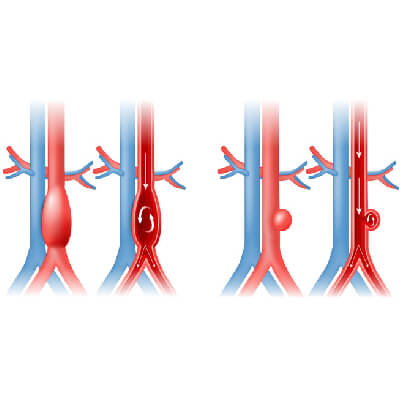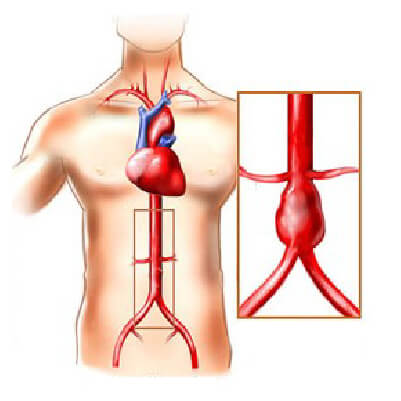ABDOMINAL AORTIC ANEURYSMS
An Aortic Aneurysm is a bulge or dilation in the wall of the aorta, the largest artery in the body. If the aneurysm ruptures, it can cause severe bleeding and potentially be fatal. Therefore, early detection and treatment are critical in managing this condition.


Causes
The exact cause of aortic aneurysm is not fully understood, but it is believed to be a result of a weakening of the walls of the aorta. Risk factors that may contribute to the development of aortic aneurysm include high blood pressure, smoking, atherosclerosis, genetic factors, and age.
Symptoms
In many cases, Aortic Aneurysms do not cause any symptoms and are discovered during routine medical exams or imaging studies for other conditions. However, if symptoms do occur, they may include:
- Pain in the chest, back, or abdomen
- Swelling or a pulsating sensation in the abdomen
- Shortness of breath
- Hoarseness or difficulty speaking
- Coughing or wheezing
Risk Factors
Several factors increase the risk of developing aortic aneurysms, including:
- Age: The risk of developing an aortic aneurysm increases as you get older.
- Smoking: Smoking damages the blood vessels and increases the risk of developing aortic aneurysms.
- Being male: As for gender, the risk is five times higher for males than females.
- High blood pressure: High blood pressure increases the risk of weakening the walls of the aorta.
- Atherosclerosis: A buildup of plaque in the arteries can weaken the walls of the aorta and increase the risk of developing an aneurysm.
- Genetic factors: A family history of aortic aneurysm increases the risk of developing this condition.
Diagnosis
Aortic aneurysm can be diagnosed during a physical exam through various imaging tests, including:
- Ultrasound: A non-invasive test that uses high-frequency sound waves to create images of the aorta.
- CT or MRI scan: These imaging tests can provide detailed images of the aorta and help determine the size and location of the aneurysm.
Treatment
The treatment for aortic aneurysm depends on the size and location of the aneurysm and the overall health of the patient. Small aneurysms may not require immediate treatment but will be monitored regularly.
Larger Aortic Aneurysms can be treated using either endovascular stent grafting or open abdominal vascular surgery, depending on the size and location of the aneurysm and the overall health of the patient.
ENDOVASCULAR STENT GRAFTING
Endovascular stent grafting is a minimally invasive procedure that involves the insertion of a stent graft, a fabric-covered metal mesh tube, through a small incision in the groin or arm. The stent graft is then guided up to the aorta using imaging technology and is placed at the site of the aneurysm to reinforce the weakened area and redirect blood flow. This procedure is generally less invasive than open abdominal vascular surgery and may have a shorter recovery time.
OPEN ABDOMINAL VASCULAR SURGERY
Open abdominal vascular surgery is a traditional surgical procedure that involves making an incision in the abdomen to access the aorta. The aneurysm is then repaired by either removing the damaged section of the aorta and replacing it with a synthetic graft or by reinforcing the weakened area with a patch or sutures. This procedure may be necessary for larger aneurysms or those in a more complicated location.
Both procedures have their own benefits and risks, and the decision on which procedure is best for you will depend on your individual condition and medical history. Our team of experienced vascular surgeons will work with you to determine the best course of treatment.
It is important to note that even after successful treatment, regular follow-up appointments and imaging tests are necessary to monitor the condition and ensure that the aneurysm has not returned or continued to grow.
An aortic aneurysm is a serious condition that occurs when a section of the aorta, the largest artery in the body, weakens and bulges. This can lead to life-threatening complications if left untreated. Aortic aneurysm symptoms often develop slowly and may not be noticeable in the early stages, which is why regular check-ups are crucial, especially for individuals with risk factors such as high blood pressure, smoking, or a family history of aneurysms. If an aortic aneurysm grows too large or ruptures, it can cause severe internal bleeding, making early detection and intervention vital.
At our clinic, we specialize in diagnosing and treating aortic aneurysms with a focus on minimizing risks and improving patient outcomes. We utilize advanced imaging technologies, such as CT scans and MRIs, to accurately assess the size and location of the aneurysm. Based on this information, our vascular specialists develop a personalized treatment plan that may include medications, lifestyle changes, or in some cases, surgery to repair the weakened area of the aorta.
Preventing the progression of an aortic aneurysm requires a comprehensive approach that includes managing underlying health conditions like high blood pressure, controlling cholesterol levels, and adopting a heart-healthy lifestyle. Our team works closely with patients to provide education, support, and ongoing monitoring to reduce the risks associated with this condition.
If you or a loved one are at risk for an aortic aneurysm, don’t wait for symptoms to appear. Early detection is key to reducing complications and improving long-term health. Contact our specialists today to learn more about how we can help manage and treat this serious vascular condition.
